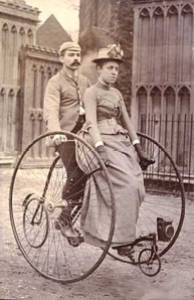“Father what is a Legislature?
A representative body elected by people of the state.
Are women people?
No my son, criminals, lunatics, and women are not people.
Do legislators legislate for nothing?
Oh no; they are paid a salary.
By whom?
By the people.
Are women people?
Of course, my son, just as much as men are.”
(Are Women People? by Alice Duer Miller)
The more I read about the women’s suffrage movement the more I stand in awe at what the many woman who went before us accomplished against great odds. They educated themselves and spoke out at a time when it was considered inappropriate at best and scandalous by many. They were arrested, went on hunger strikes, and in the case of Emily Davison died after being run over by a horse. Many had the support of fathers or husbands who agreed with them and supported them, but others opted not to be constrained by the bonds of marriage.
The women who fought for the right to vote in the United States and Great Britain were as varied as women are today. They were Atheists and Quakers, school teachers, writers, speakers, and housewives. Many of them were abolitionists. There were harsh disagreements between them about what the goals were and how they could be achieved. For many the original goal wasn’t even the right to vote, but simply the right to be seen as equal before the law in things such as property rights.
It is difficult to say when the women’s suffrage movement began. One landmark event, however, was the Woman’s Rights Convention in Seneca Falls, New York, held July 19 – 20, 1848. According to Elizabeth Cady Stanton’s own account it was organized on short notice. Lucretia Mott and her husband were visiting the area and five women met for tea – Lucretia Mott, Mary Ann McClintock, Martha Coffin Wright, Elizabeth Cady Stanton, and Jane Hunt. Together they decided to hold a convention and placed an ad in the local newspaper the next day, July 14, 1848.

Prior to the convention Stanton, with help from the other women, drafted a Declaration of Sentiments based on the Declaration of Independence, declaring that “all men and women are created equal.” Attached to this was a list of grievances. The Convention would take place over two days, the first of which would include only women where the Declaration of Sentiments would be discussed one paragraph at a time and modified as necessary. The second day, men were invited to attend. Ironically, Lucretia Mott’s husband, James, was asked to moderate the meeting on the second day because it was considered inappropriate for a woman to preside over a meeting with men in attendance.

During the discussion of the second day, the only resolution to cause much dissent was the ninth, added by Stanton.
Resolved, that it is the duty of the women of this country to secure to themselves their sacred right to the elective franchise.
Even Lucretia Mott thought it shouldn’t be included. Most were concerned that it would detract from the other resolutions that they believed were more reasonable. The tide turned when Fredrick Douglass rose to speak. He was an eloquent speaker and convinced the crowd that the country would be better off if women were involved in the political sphere as well as social and religious affairs. The resolution passed.
In spite of the passage of all the resolutions, there were undercurrents of disagreement and discontent. Of the 300 attendees, only 100 signed the Declaration. Word got back to Stanton in the following days of the condemnation of the convention from various pulpits, even though the convention had been open to comments from the floor. Newspapers published opinions from both ends of the spectrum. As contentious as the feminist movement in recent times has been you can imagine the reaction they received in a time when women were in many ways considered the property of the men in their lives.
Over the next seventy years, there would be many disagreements between the women and men involved in this fight. The fight to achieve the vote for African-American men after the Civil War, would cause division, some feeling that the two causes must be separated or risk losing the right for black men. When it became clear that the resistance in Congress to women’s suffrage was too strong, the issues were separated and the Fifteenth Amendment passed giving African-American men the right to vote. Another major disagreement would be over the approach, fighting for the right one state at a time or pushing for a constitutional amendment. Ultimately, each of these things occurred.
Some consider the Seneca Falls convention a minor event in the history of suffrage. Women had been working in small local groups for women’s rights for years. Two years later, in 1850, the National Women’s Rights Convention organized by Paulina Wright Davis and Lucy Stone would draw women from across the country. Seneca Falls may only be symbolic, but regardless the movement was on its way.
There are many women who contributed to women’s rights in general and suffrage in particular over the years. Most of the women at Seneca Falls wouldn’t live to see the Nineteenth Amendment pass. In future posts I want to look at women in this earlier generation, but also at some of the women who brought the dream to fruition here in the US and also in Great Britain.
To see the entire Declaration of Sentiments click here.
Read more about the suffrage movement here.
Resources
Are Women People? A Book of Rhymes for Suffrage Times by Alice Duer Miller
A People’s History of the United States by Howard Zinn
Eight Years and More by Elizabeth Cady Stanton
Other Powers: The Age of Suffrage, Spiritualism, and the Scandalous Victoria Woodhull by Barbara Goldsmith








